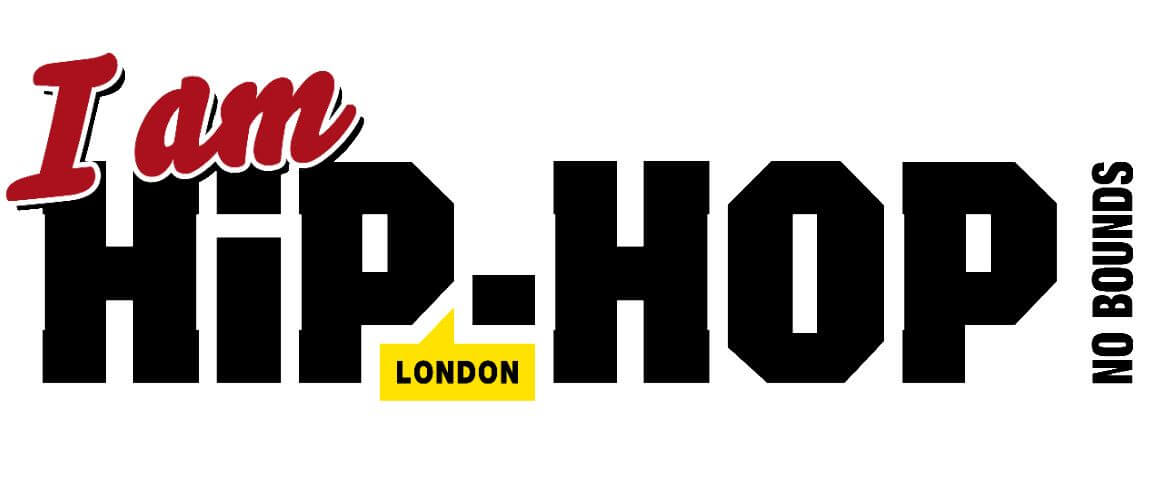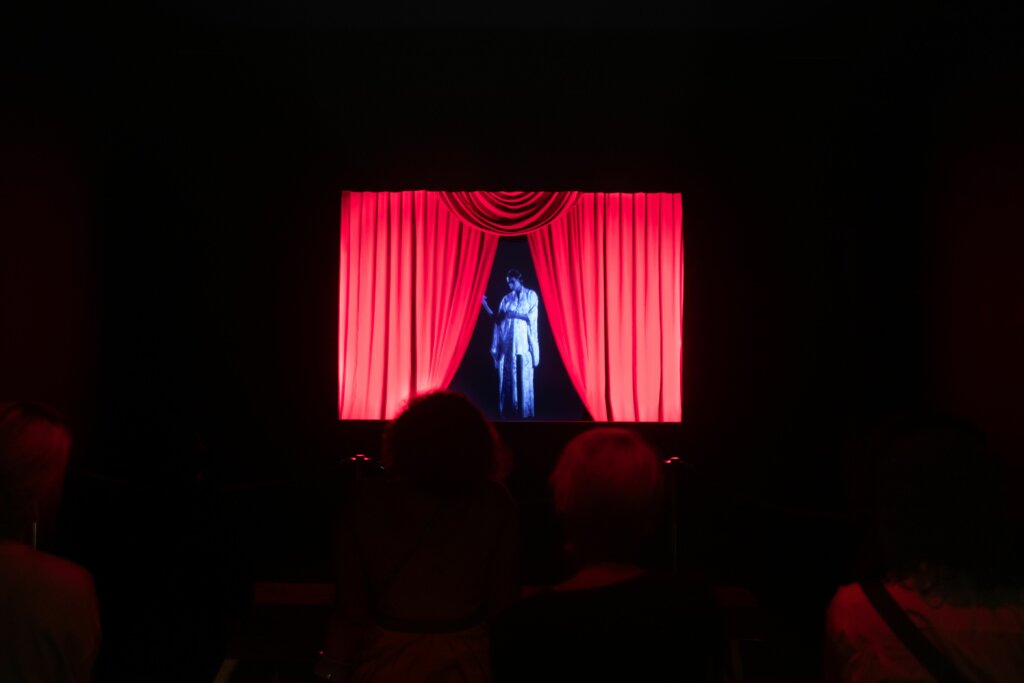
‘Lonie ‘, Carrie Mae Weems: Reflections for Now Installation view Barbican Art Gallery, 2023 © Jemima Yong
For a long time, I’ve engaged in an on-going conversation in my head, debating whether art is an indulgent gift – to both make and experience – or something deeply vital to existence, to human life, to making social impact, to genuine change. My position has fluctuated constantly in the now decades I’ve been having this discussion with myself. In my current stance (that might change again) I’m less concerned with having a definitive answer, but am largely convinced that there’s no ‘either/or’ choice to be made. The statements don’t negate each other. It is a genuine luxury to spend hours in an art space or listening to music, breathing in the work, reflecting on the feelings and provocations it gives, never mind dedicating a life to studying and playing with techniques and mediums to interpret, express and pass on these thoughts in your own way. However, I now feel very strongly that this experience is essential for some people’s existence, that it greatly benefits humans in general and, importantly, can incite within people the motivation, means and ability to think, act and feel differently than they did before experiencing given pieces of work.
I think this is one definition of social change, especially when the ramifications of this process happening over and again, making infinite overlapping ripples in the world, is properly taken into consideration. There are many artworks, many artists, that poses the power to profoundly impact audiences is this way. When that happens, the effects can change people. Carrie Mae Weems is undoubtably such an artist; I know because her work changed me.
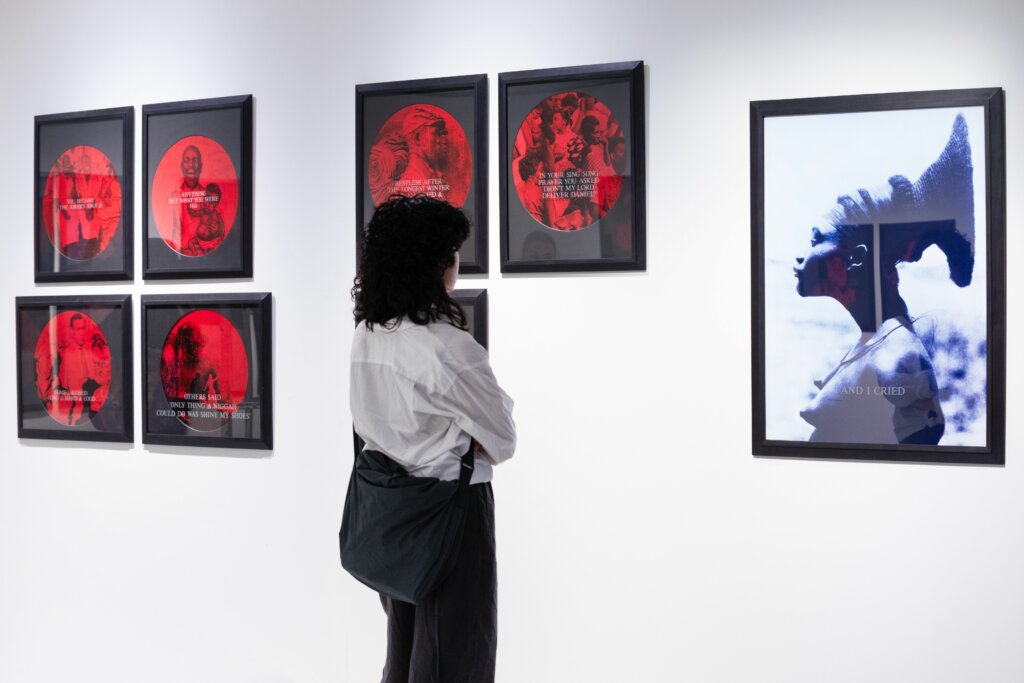
‘From Here I Saw What Happened and I Cried’, Carrie Mae Weems: Reflections for Now Installation view Barbican Art Gallery, 2023 © Jemima Yong
When I was around 18, discovering who I am, defining what purpose I’d strive to achieve in my life, I’d spend a lot of time in museums and public art galleries. In London the big ones are free. This is important when you don’t have much money. I’d go and take the free education and try to reconcile the tensions between acknowledging how fortunate I was to have access to so many resources, while studying how intricately interwoven these institutions are to colonial and imperial domination, and how so many of the things I’d be looking at were largely products of the pillage central to the the genocide of my people and now were used to sustain the world built through this pervasive violence.
It was on one of these trips to Tate Modern that I stumbled across ‘From Here I Saw What Happened and I Cried’. In a building made to dictate the legacy of a man who profited from industrialised plantation slavery and one of its primary crops, amongst work that (I considered at that time) often objectifies, divides, trivialises, distracts and placates, I found something that spoke to me, about me, across time and space, connecting me to my Ancestors and my Descendants, undermining the lies told about us, celebrating our resoluteness, the resilience passed down through generations. The work spoke viscerally, with a defiant fist, a tender touch, a cavernous empathy, sorrowful wail and loving embrace. The masterpiece of visual, multiform poetry repurposes photographs intended to dehumanise African and African diasporic people and uses them to instead tell the story of our enduring humanity. It speaks to and through the intergenerational depravity that has been waged against us, but also the lives we have used to resist against, survive and flourish within, though not without grave costs.
I wandered around the room, absorbing each element and the whole piece for a very long time. I don’t know how long. It was the first piece of visual art in a famous gallery that had ever moved me in this way. I didn’t truly understand the impact it had made on me until I was stood in front of it again, 18 years later, at Carrie Mae Weems first major solo exhibition in britain at the Barbican. Weems is a giant of contemporary art. Prolific, wide reaching in subject and scope. It says more about the ‘art world’ in britain than her that this is her first show of this scale here. But it is here now…and it is spectacular.
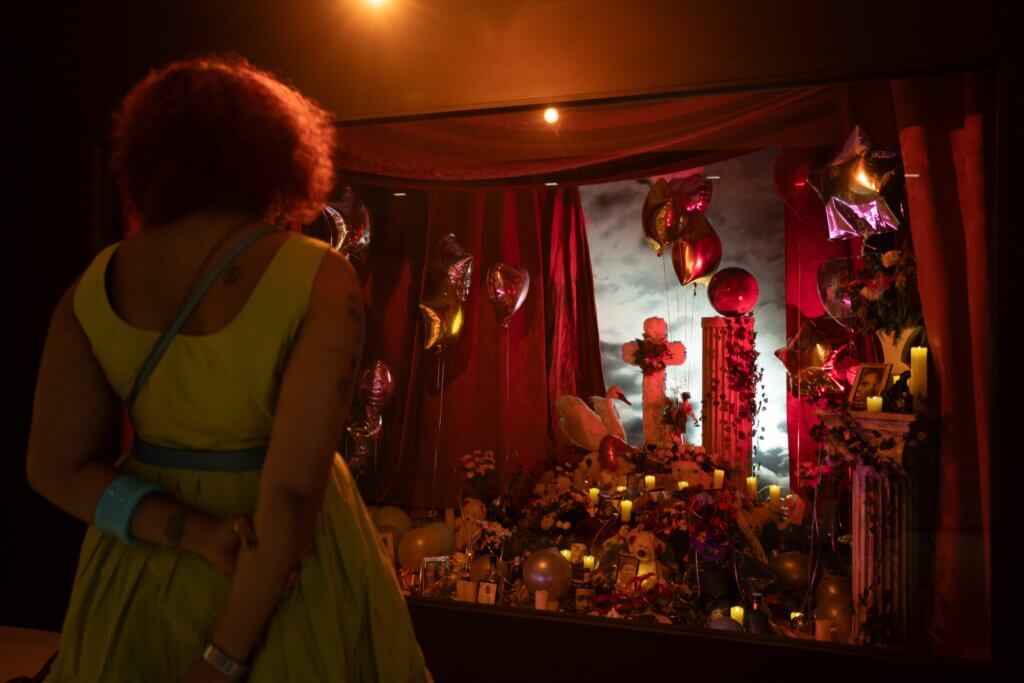
‘It’s Over—A Diorama’, Carrie Mae Weems: Reflections for Now Installation view Barbican Art Gallery, 2023 © Jemima Yong
‘Carrie Mae Weems: Reflections for Now’ brings together major works that span her life and career, with a focus on the past 30 years. You are treated to an opportunity to experience the power of her in-depth investigation of African diasporic life, centered in the united states but with global resonance.
Among many connected themes, Weems’ work pushes the boundaries of multiple media, including language, and examines the nature of power, time, social relationships and hierarchies, what it is to be a woman, Blackness and crucially, the violence of whiteness that society and the individuals who construct it have been subjected to.
In the first of two talks I was honoured to hear her give, in the groves of the Barbican’s Conservatory, Weems expressed that although her work may be considered primarily ‘for’ and ‘from’ Black people, it is as much about whiteness as it is about Blackness, as the two are so intimately connected.
Weems spoke of her practice, beautifully describing the rites and ritual of using music to set the tone and rhythm of her day as she begins to write, journeying through these portals to the space from which creation comes through her and into her photography, film, installations and more, all of which she describes as ‘texts’ — constructs through which ideas can be channelled into and communicated from. The exhibition flows like a text written from such a perspective. After entering the main door, you’re guided to the gallery’s staircase, where you can feel the ominous, darkened realm above, drawing you in. The incredible curation of Weems, Florence Ostende and Raúl Muñoz de la Vega has created a powerful Spacetime within which the universe that Weems has spent her life cultivating and traversing is expanded and contained for us to explore.
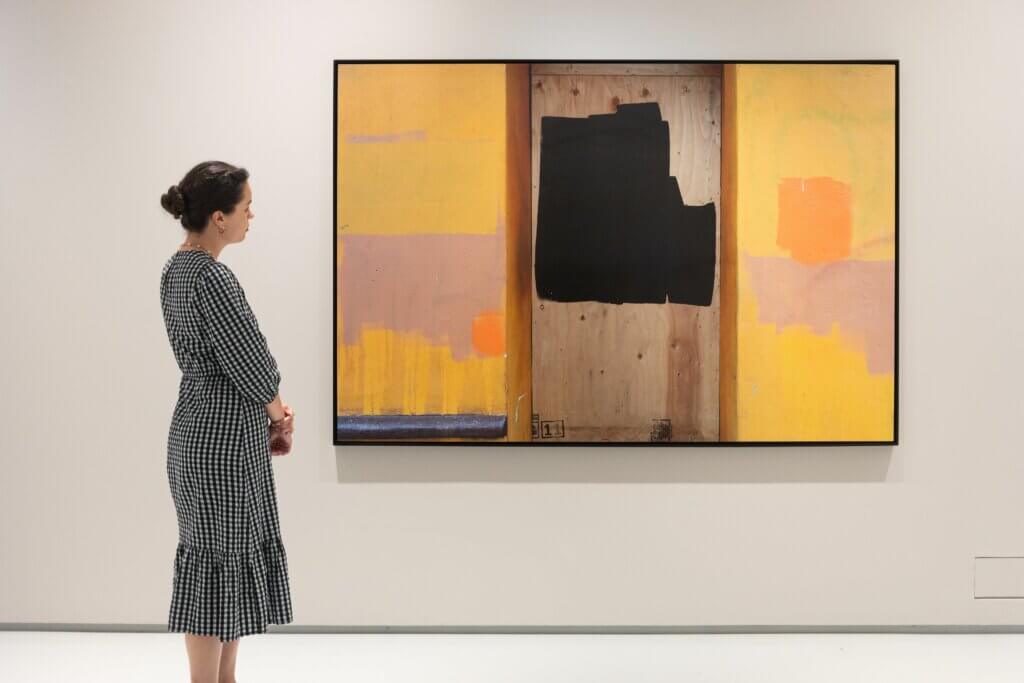
‘Painting The Town’ Carrie Mae Weems: Reflections for Now Installation view Barbican Art Gallery, 2023 © Jemima Yong
With Time so central to her works, it is poetically adept that, for a retrospective, the audience enter at the present. One of Weems’ latest works ‘Painting the Town’ (2021), a series of photos that at first glance appear as paintings, demonstrate immediately what is so powerful about Weems’ work. This lack of immediate clarity in medium delays the realisation that the focus of this series is indeed paint; slogans painted in protest painted over to project an oppressive perspective. Weems and her team captured the aftermath of the 2020 uprisings in the united states, specifically Portland, and the response of the city’s administration and businesses to blot out the graffiti left on walls and buildings. Weems has edited the pictures to resemble work from the abstract expressionist movement, drawing parallels with how Black artists were painted out of the movement, just as calls for justice and affirmations on the sanctity of Black life were erased from the city.
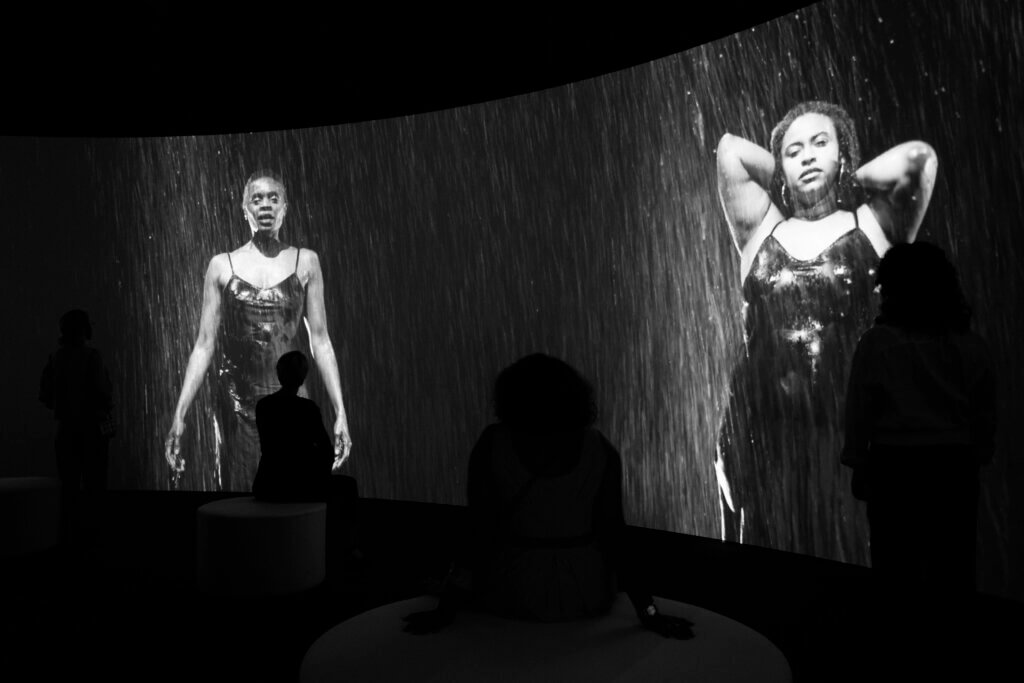
‘The Shape of Things’, Carrie Mae Weems: Reflections for Now Installation view Barbican Art Gallery, 2023 © Jemima Yong
From this suggested starting point, the curation moves between timeless pieces, often set to the sonic backdrop of the epic ‘The Shape of Things’ (2021) that leaks out of its panoramic amphitheatre, adding to the experience of many other pieces, soaked audiences in its ambience. One of these pieces is the iconic ‘Kitchen Table Series’ which was also brought to life as a direct influence of the impeccable ‘The Score(s): III’ performed by the amazing i.as.in.we (Yewande YoYo Odunubi and Rohan Ayinde), one of the many brilliant events that celebrated the opening of the exhibition. Another of these was the second talk I got to experience, an hour-long keynote in the Frobisher Auditorium. Weems performance was captivating, opening by dancing to Aretha Franklin and Frank Sinatra, outlining her perspective on interpretation and artistry before guiding us sincerely, uncompromisingly self-assured through a lifetime of making, witnessing, forging and kicking down doors.
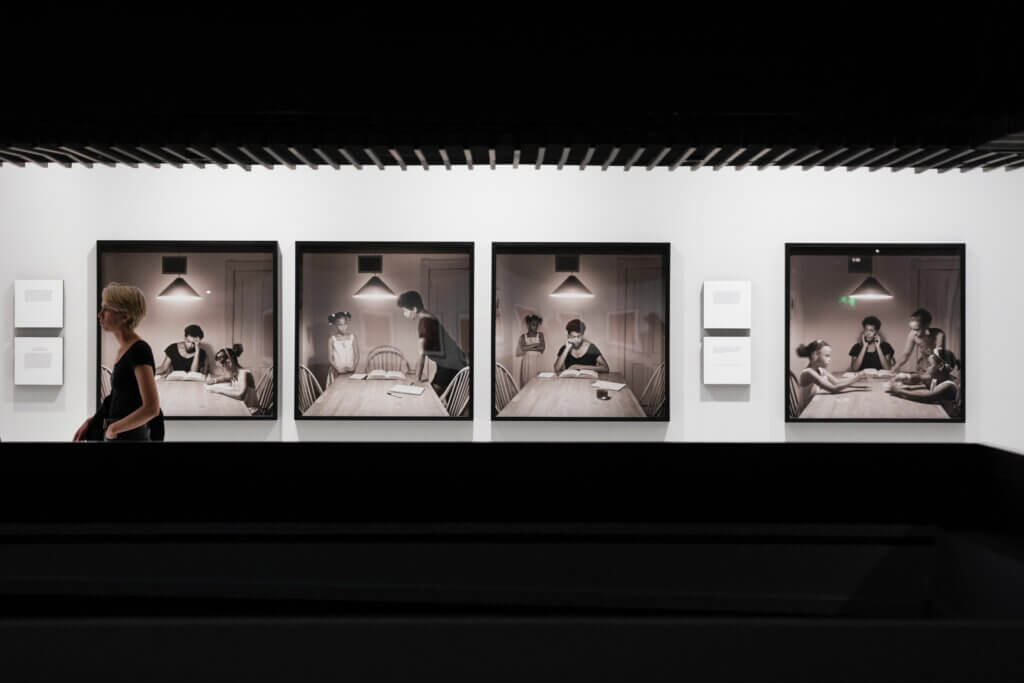
‘Kitchen Table Series’ Carrie Mae Weems: Reflections for Now Installation view Barbican Art Gallery, 2023 © Jemima Yong
Carrie Mae Weems is a force, of nature, to be reckoned with, to be experienced. She spoke with such poignancy about how so many African (particularly American) women, despite being recognised for their excellence and influence, spend their later life unappreciated, undervalued and often alone. This exhibition, I hope, demonstrates that this will not happen to her; it cannot be allowed to happen. Having now been 3 times – I might even go again – be good to yourself, go experience this before it ends on September 3rd, and contribute to stepping this hope into reality. This is her first retrospective in britain, but it should not be her last.
For more information, watch the trailer and promotional interview below (with the amazing Ronan McKenzie) and follow the link. Friday from 5pm-8pm ‘pay what you can’ tickets are available, and there are still accessibility sessions available.
Info and Tickets: https://www.barbican.org.uk/CarrieMaeWeems
